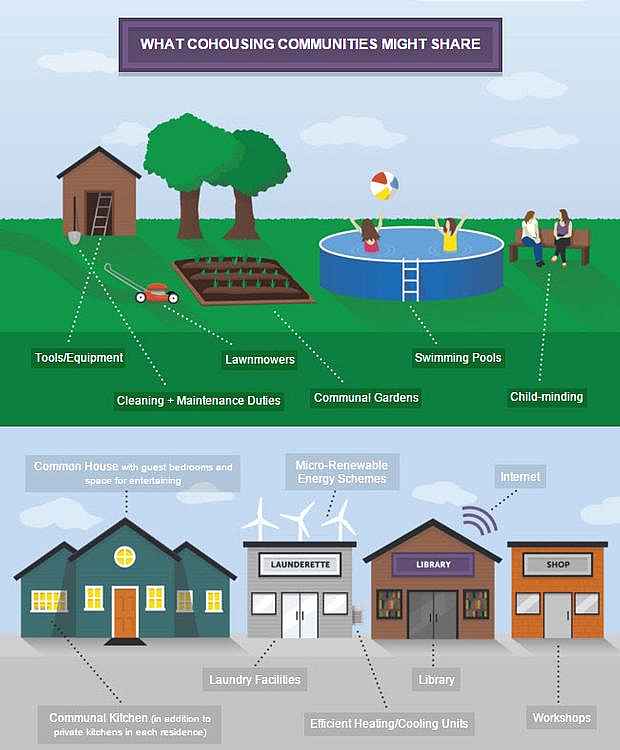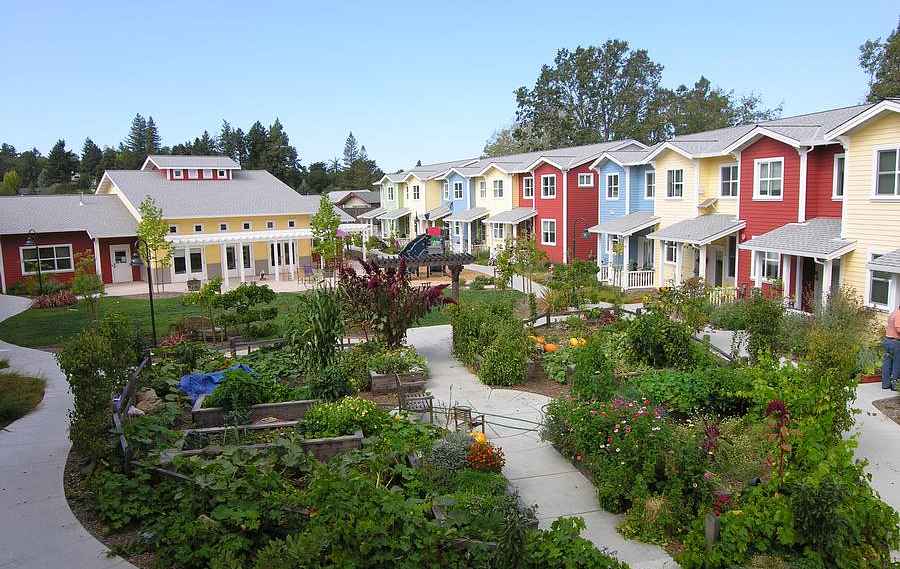






See listing of Recent and Most Popular articles on the Home Page
Finance and Legal
Category: Housing and Living Options / Topics: Housing • Optimal Aging • Relationships • Social Issues • Trends
Exploring Cohousing
by Stu Johnson
Posted: February 24, 2016
Looking at housing options, starting with cohousing…
For two decades now I have served on the Housing Commission for the City of Wheaton (Illinois). Our primary purpose is to administer a Senior Housing Assistance program, which provides small subsidies to low-income seniors to enable them to remain in Wheaton. The Commission is also tasked with looking into housing issues to help inform the City Council.
At a recent meeting we were discussing alternatives for affordable housing, which is an increasing problem in places like the Chicago area (Wheaton is in one of the "collar" counties) where housing costs are high. Affordability is difficult to secure using typical building types in most areas of the country—a mix of single family houses, apartments or condominiums, town house complexes—models based on autonomous household units.
There are some options for sharing, but that basically puts people together in a larger house where they share common areas (and therefore, the communal aspects of living together). It is unusual to find structures or communities designed for that purpose in our area.
One commissioner cited an example in Chicago where one floor of an office building had been converted into an SRO (Single Room Occupancy)—not the seedy Skid Row hotel that might come to mind, but a very up-to-date arrangement of individual living units for private space and common areas for eating, leisure and recreation. Retirement communities meet the need in a similar way for many people, but they can be an expensive option beyond the reach of many.
The problem in areas with traditional building units is recognizing that there are other ways to meet housing needs in an affordable and socially healthy way. Doing so, however, will likely require changes to building codes and zoning so that builders are able to construct them (both legally and by being financially viable).
I also want to explore these options on SeniorLifestyle. Not all may be available or even feasible at this time where you live. But exploring the options and seeing how they work may inspire you and others to become advocates for them where you live. That brings me to co-housing, one of the first of these alternative approaches that I would like to explore.
 Have you heard of "co-housing"? It's been around for a while, especially in Denmark and the UK, new to other areas, and not yet available in many other areas. I was made aware of an "Infographic" about co-housing. The Infographic is a web page from the UK, presented by Towergate Insurance . It presents the concept in an interesting and easy-to-understand visual approach.
Have you heard of "co-housing"? It's been around for a while, especially in Denmark and the UK, new to other areas, and not yet available in many other areas. I was made aware of an "Infographic" about co-housing. The Infographic is a web page from the UK, presented by Towergate Insurance . It presents the concept in an interesting and easy-to-understand visual approach.
A few facts from the Infographic (with some British English spelling):
- Cohousing communities are communities organised collaboratively. Residents have their own private spaces but band together to share meals and facilities, organise activities and look out for each other.
- The focus is on community. All that’s required is a neighbourhood where people want to band together, take care of one another and collaborate for the good of all.
- Sizes vary, most in the U.K. range from 10-40 households. Some are for women or seniors only, but most are a mix of single people, couples, children and elderly residents.
- Shared resources are common elements, but vary considerably from one community to another. It can include such things as sharing tools and equipment, cleaning and maintenance duties, communal gardens, swimming pools, childcare ("child-minding" in the U.K.), and vehicles.
- Shared facilities put the "co" in co-housing," which may include such things as a communal kitchen and dining area, workshops, laundry, office spaces, and efficient heating and cooling—things that do not need to be duplicated in each unit and also promote a shared lifestyle.
- Advantages include affordability, safety, sustainability, security and a strong social network.
- According to the U.K. Cohousing Network, "Cohousing is a way of combating the alienation and isolation many experience today, recreating the neighbourly support of the past." The Infographic includes a number of compelling statistics.
- Community is healthy. Living alone can increase depression, the risk of dementia and heart attack, and unhealthy habits such as smoking.
 Co-housing has appeared in a few states in the United States. The website of The Cohousing Association of the United States has this answer to the question, "What is Cohousing?"
Co-housing has appeared in a few states in the United States. The website of The Cohousing Association of the United States has this answer to the question, "What is Cohousing?"
Cohousing is an intentional community of private homes clustered around shared space. Each attached or single family home has traditional amenities, including a private kitchen. Shared spaces typically feature a common house, which may include a large kitchen and dining area, laundry, and recreational spaces. Shared outdoor space may include parking, walkways, open space, and gardens. Neighbors also share resources like tools and lawnmowers.
Households have independent incomes and private lives, but neighbors collaboratively plan and manage community activities and shared spaces. The legal structure is typically an HOA, Condo Association, or Housing Cooperative. Community activities feature regularly-scheduled shared meals, meetings, and workdays. Neighbors gather for parties, games, movies, or other events. Cohousing makes it easy to form clubs, organize child and elder care, and carpool.
Common Characteristics
Relationships
- Neighbors commit to being part of a community for everyone’s mutual benefit.
- Cohousing cultivates a culture of sharing and caring.
- Design features and neighborhood size (typically 20-40 homes) promote frequent interaction and close relationships.
Privacy and Community
- Cohousing neighborhoods are designed for privacy as well as community.
- Residents balance privacy and community by choosing their own level of engagement.
Participation
- Decision making is participatory and often based on consensus.
- Self-management empowers residents, builds community, and saves money.
Shared Values
- Cohousing communities support residents in actualizing shared values.
- Cohousing communities typically adopt green approaches to living.
In addition to future articles on housing options, watch for more information and links in the Housing and Living Options category in the Resouce Center of SeniorLifestyle.
Search all articles by Stu Johnson
Stu Johnson is principal of Stuart Johnson & Associates, a communications consultancy in Wheaton, Illinois. He is publisher and editor of SeniorLifestyle, writes the InfoMatters blog on his own website and contributes articles for SeniorLifestyle. • Author bio (website*) • E-mail the author (moc.setaicossajs@uts*) • Author's website (personal or primary**)* For web-based email, you may need to copy and paste the address yourself.
** opens in a new tab or window. Close it to return here.
Posted: February 24, 2016 Accessed 1,944 times
![]() Go to the list of most recent Finance and Legal Articles
Go to the list of most recent Finance and Legal Articles
![]() Search Finance and Legal (You can expand the search to the entire site)
Search Finance and Legal (You can expand the search to the entire site)
![]() Go to the list of Most Recent and Most Popular Articles across the site (Home Page)
Go to the list of Most Recent and Most Popular Articles across the site (Home Page)
 Loading requested view...
Loading requested view...